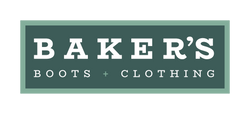Boot Glossary
B
B width
"B" width refers to an extra narrow width.
Boot tree
a form used to keep boots in shape when they are not being worn. Also known as "wooden feet", boot trees are designed to be inserted into the foot of the boot with relative ease, thanks to slide or spring action built into and underneath the wood. They are regaining popularity and can be readily purchased. Older ones were usually made of maple, but today cedar is more common because of its deodorizing quality.
Bootjack
A tool that enables the boot wearer to remove boots while standing. The first boot jacks were made of wood and had a forked end to hold the heel of one boot while the wearer pulled his foot out of the other. Bootjacks gave rise to the catchy expression "Once you use a jack, you will never go back."
C
C width
"C" refers to a narrow width.
Collar
The material sewn into the opening, or the topline, of the shoe. The collar can be padded to provide increased support or comfort.
Counter
A stiff piece of material (typically leather) used to maintain a shoe's shape, and which is inserted between the shoe's lining and upper materials.
Crepe Sole
A kind of sole typically cast from rubber and made to resemble the texture of wrinkled crepe paper. These soles are almost exclusively seen on casual shoes and older style boots.
Custom make-up
A term used by boot factories to describe their version of custom-made boots. The major difference is that there is no custom last, nor are there any measurements involved. A stock factory last in a standard size that comes as close as possible to accurately fitting the customer's foot is used instead.
D
D width
"D" width refers to a medium or standard width.
Die
A metal pattern with razor-sharp edges that works like a cookie cutter. It is used to cutout sections of the boot in various shapes; these are then glued and sewn together to form the vamp, counter, and top of the boot.
E
EE width
"EE" width refers to a wide width.
EEE width
"EEE" width refers to an extra wide width.
F
Footbed
A term sometimes used to denote a shoe's insole.
Full Grain Leather
Leather that has been tanned so that the a natural texture, or grain, of the animal skin is visible.
H
Handmade
Boots that are built entirely from scratch by hand the old way. There is little or no machinery involved, other than a foot-pedaled sewing machine for some of the fine stitching.
Heel
The part of shoe that is attached under the heel of foot, and which varies in height and material according to the style of the shoe. In dress shoes, the heel is often fabricated separately from the shoe's sole.
I
Insole
The inner sole of the shoe, which is often cushioned for comfort, molded for orthopedic reasons or hard for supportive comfort.
Instep
The area of the foot between the toes and the ankle, or the top front part of a shoe
L
Last
An Old English word for footstep. The last is the model used to make all custom and factory boots.
Until recently it was always carved from wood, but now fiberglass poured into foot molds has almost entirely replaced wood. The toe, however, can be fastened to the end of the last in any style the customer desires. And small pieces of leather are shaped and glued and then sanded down smooth to compensate for any irregularities in a foot or changes that occur normally as a customer ages
N
Nailed Construction
Refers to shoes that have their pieces nailed together, instead of sewn.
Nubuck Leather
A kind of leather with a slight 'nap' and otherwise smooth finish, which is achieved by 'bucking'Â? (or sanding) the hide
O
Outsole
The bottom-most part of the shoe's sole usually rubber or leather.
P
Pull holes
Finger holes at the tops of boots that replace pull straps and are very often used by working cowboys.
Pull straps
Straps that are used to assist in pulling the boot on. They can be on the outside or the inside of the boot in any size or shape.
Q
Quarter Panels
The side components of the shoe, which run from its heel to its toe.
R
Roper
A style of boots with a wide, round toe, no decorative stitching, usually a nine-to-ten-inch top, and a low walking heel.
S
Scallop
The V-shape in the front and back of the cowboy boot. This can be shallow or cut very deep.
Shaft
From heel to toe, this term refers to the all the parts of the shoe that cover the top of the foot.
Shank
The portion of the boot that is used as reinforcement for the wearer's arch. Most boot makers today use a thin, pre-cut strip of eighteen-gauge steel, which is glued, whip stitched, or tacked in place.
Stay
The strip of leather that runs up and down the back of the inside of the boot lining to stiffen and support the boot and hold up the top. Also knows as a "back stay."
T
Test Term
This is a test term.
Toe box
A stiff piece of material that is placed in the top of the boot toe between the outer vamp leather and the lining to reinforce the shape. All toe boxes used to be made of leather until the advent of super man-made materials. However, many custom boot makers still use leather, while the factories use plastic or man-made toe boxes.
Toe Bug
Also referred to as the "toe flower," "medallion," "fleur-de-lis," or just plain "toe stitch." Every boot maker has his favorite design. It becomes their signature and can identify the boot to others. Usually only one or two rows of stitching are used to create a delicate and artful design. You seldom see cowboy boots without decorative toe stitching unless they are made from exotic skins, in which case the stitching would not be visible.
Toe Vamp
This term is used to refer to the front center part of a shoe's toe and usually is sewn to the upper and counter.
U
Underslung
A descriptive word for the angle of the back of the heel. Underslung heels are also sometimes said to be "undershot." From 1880 to 1960, most cowboy boots had higher heels. To keep them from having a heavy, blocky shape, boot makers hand-fashioned the backs of the heels to angle toward the foot.
Upper
From heel to toe, this term refers to the all the parts of the shoe that cover the top of the foot.
W
Welt
A strip of heavy leather that is sewn around the lasting space of the upper and joins it to the insole. The sole is then stitched to the welt with a second seam.



